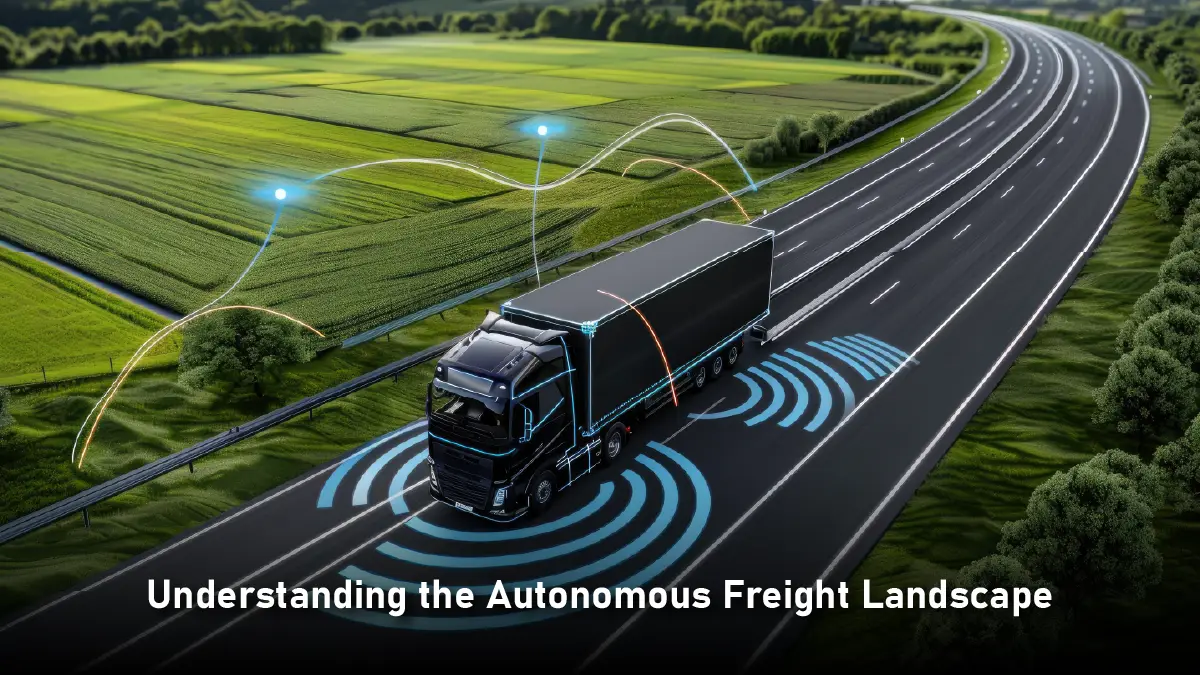Diesel engines have powered global commerce for decades. Their rumble is a constant presence. Yet, a profound shift is underway, quieter but no less powerful. Autonomous freight technology is growing fast. It’s moving from science fiction ideas to real assets that will change supply chains. Smart business leaders now wonder not if this technology will change operations, but how and when to use it well. If you ignore this change, you risk losing your edge. Embrace it wisely, and you’ll gain great efficiency, resilience, and better cost control. Here’s how to navigate this integration with the precision it demands.
Understanding the Autonomous Freight Landscape

Autonomous freight isn’t a monolithic solution. It includes various technologies. Each one fits a specific role and develops at its own speed. Understanding these nuances is paramount for strategic planning.
Long-Haul Trucking: This segment is very noticeable. Companies are creating advanced self-driving systems for highway travel.
This effort aims to:
- Boost safety
- Improve fuel use with steady driving habits
- Tackle the ongoing driver shortage in the industry
Picture fleets running almost non-stop. They cover long distances with little human help on the dull highway stretches.
Also Read: What is Supply Chain Risk Management?
Middle-Mile and Drayage: These routes are usually short and repetitive. They connect distribution centers, ports, and rail yards. So, they are great options for early autonomy. These controlled environments present fewer variables than dense urban settings. Automating drayage is key for intermodal trips. It can cut congestion and speed up turnaround times at ports, reducing a major bottleneck. For instance, Volvo Autonomous Solutions and DHL Supply Chain have initiated driverless truck operations between Dallas and Houston, utilizing advanced sensors for obstacle detection.
Last-Mile Delivery: Fully autonomous sidewalk robots and drones make headlines. They aren’t ready for widespread use yet. This is especially true for different types of parcels. Autonomous solutions for hub-to-hub transfers in urban areas are growing quickly. Imagine small self-driving cars delivering items from a local depot to nearby pick-up locations.
Enabling Technologies: The real strength of autonomy comes from the ecosystem, not just the vehicles. Advanced telematics, real-time freight visibility platforms, predictive analytics, and fleet management software form a digital nervous system. This system enables profitable and seamless integration. These systems manage movement, adjust routes in real-time, and supply essential data support. Uber Freight employs AI-driven platforms to optimize truck routing, reducing empty miles by 12% and enhancing operational efficiency.
The maturation curve is steep. Major players, from traditional OEMs to dedicated tech startups, are investing billions. Pilot programs are shifting from tests to real money-making operations on specific routes. The potential impact is huge. Industry analyses show major cuts in operating costs, especially for fuel and labor. They also highlight big safety improvements by reducing human error during autonomous operations. A major study from a top management firm found that self-driving technology could save the US freight sector more than three hundred billion dollars each year for the next decade.
A Phased and Purposeful Approach
Integrating autonomous freight isn’t about flipping a switch overnight. It demands a deliberate, phased strategy aligned with core business objectives. Acting too quickly can cause mistakes, but being too careful can let opportunities pass by.
Define Your “Why”: Clarity of purpose is non-negotiable. Are you focused on lowering high line-haul costs? Fuel price changes and driver wages make this harder. Is enhancing safety performance and reducing accident-related liabilities a top priority? Do you need to solve crippling capacity constraints on specific high-volume lanes? Improving reliability and on-time delivery is crucial, especially with unpredictable human factors. Identifying the main goals shapes the integration path. It also determines which technologies to prioritize and how to measure success. Avoid the trap of pursuing autonomy simply because it’s novel.
Audit Your Current Operations: Conduct a rigorous assessment of your existing logistics network. Find lanes with high mileage, steady routes, and easy operating conditions. These are your best options for starting autonomous deployment. Examine cost structures to see where autonomy can save the most money. This includes areas like fuel, driver pay, and insurance. Check your tech setup. Old systems often struggle to process data in real-time. They also find it hard to integrate, which is important for autonomy. This audit reveals the low-hanging fruit and highlights necessary upgrades.
Start with Pilots, Think Scale: Begin with tightly scoped, well-defined pilot programs. Select a single lane or a specific operational segment (e.g., dedicated port drayage). Team up with trusted autonomous tech providers. They should show strong skills and a solid grasp of real-world operations. Also, they must be dedicated to working together. These pilots are invaluable learning labs. They give clear data on performance, reliability, safety, and real operational costs for your situation. Crucially, they build internal organizational familiarity and confidence before broader rollout. Document everything meticulously; successes, challenges, and unexpected insights.
Embrace the Hybrid Model: The future will be hybrid, not just autonomous, for now. Human drivers are crucial for navigating complex urban areas. They handle unexpected situations, supervise loading and unloading, and interact with customers. The best strategy uses autonomous technology on long highway stretches. It works well for efficiency and safety. Then, it hands control back to human drivers for the tricky first and last miles. This maximizes the strengths of both humans and machines. Technology exists to facilitate smooth handoffs, ensuring operational continuity.
Invest in the Digital Spine: A strong digital infrastructure is key for good integration. This means putting money into cloud-based Transportation Management Systems. These systems can manage complex routes, including autonomous legs. Implement advanced telematics and real-time visibility platforms that provide granular tracking and monitoring. Use predictive analytics to forecast demand. Optimize asset use across mixed fleets, both autonomous and traditional. Also, manage maintenance proactively. Make sure data flows smoothly between your ERP, WMS, and the new fleet management systems. Interoperability is key; avoid data silos.
Navigate the Regulatory Maze: Regulatory rules for autonomous freight are changing fast. However, they differ widely between regions. Engage proactively with industry associations and regulatory bodies. Stay updated on laws and permits for the areas where you operate autonomous vehicles. Compliance is non-negotiable. Build relationships with policymakers. Show safety and operational benefits responsibly. This helps create positive regulations. Factor regulatory timelines into your implementation roadmap.
Prioritize Cybersecurity: Connected and autonomous vehicles represent significant new cyber-attack surfaces. A breach could have catastrophic safety and operational consequences. Make cybersecurity a foundational element, not an afterthought. Require strong security measures from tech providers. This includes tough encryption, safe communication channels, and secure over-the-air updates. Implement stringent internal cybersecurity policies and conduct regular vulnerability assessments and penetration testing. Protect vehicle and logistics data just like you protect sensitive financial information.
Addressing the Human Element

The specter of job displacement understandably causes concern. According to American Trucking Associations, the trucking industry faces an ongoing driver shortage, with projections indicating a deficit of over 160,000 drivers by 2031. Responsible integration requires proactive workforce strategies. Frame autonomy as a tool augmenting human capability, not replacing it wholly. Invest significantly in reskilling programs.
Train drivers to be skilled ‘autonomy operators’ or ‘remote vehicle supervisors.’ These roles focus on:
- Monitoring fleets
- Managing exceptions
- Handling complex handovers
- Performing higher-value tasks like customer service or specialized vehicle maintenance
Develop clear career progression paths within this new operational paradigm. Clear communication about changes and their timeline is key. Also, providing real support for workforce transitions helps keep morale high. This approach secures buy-in from important team members. Leading companies in workforce transformation will enjoy a more engaged and future-ready team.
Measuring Success and Future-Proofing
Integration is an ongoing journey. Establish clear Key Performance Indicators aligned with your initial objectives.
Track metrics such as:
- Cost per mile (compare autonomous and traditional lanes)
- On-time delivery performance
- Fuel efficiency gains
- Safety incident rates
- Asset utilization rates
- Driver retention and satisfaction in new roles
Analyze this data relentlessly to refine operations and demonstrate ROI.
The technology will continue to evolve at pace. Foster a culture of continuous learning and adaptability. Keep good ties with different technology providers. This helps avoid lock-in and keeps you updated on new innovations. Think about how autonomy can create new business models. For example, it can lead to fast just-in-time delivery networks. It can also enable dynamic pricing that adjusts based on real-time autonomous capacity. View your logistics network not as a static entity but as an adaptive system.
The Autonomous Advantage Awaits
Autonomous freight is not a distant fantasy; it’s an operational reality unfolding now. Business leaders must be proactive. They need to integrate strategies to build a strong logistics operation. This approach ensures the operation is competitive and resilient for the future. The journey needs careful planning and a big investment in technology and people. It also requires a readiness to handle changing regulations. Start with focused pilots. Embrace the hybrid model. Build strong digital infrastructure. This will support the new era.
The rewards, however, are transformative. Lower operating costs, better safety, and improved capacity use give a strong edge. Greater reliability and easy scaling during demand changes also help. Companies that excel in using autonomous freight will improve their supply chains. They will also change the game in logistics. This shift will set a new standard for efficiency and service in their fields. The silent revolution is here. The time to chart your course is now.




